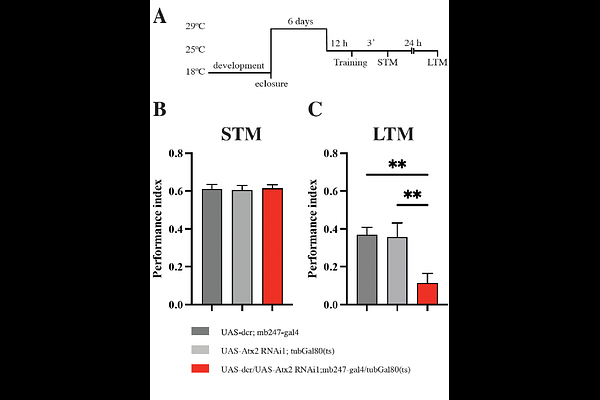The Ataxin-2 protein is required in Kenyon cells for RNP-granule assembly and appetitive long-term memory formation.

The Ataxin-2 protein is required in Kenyon cells for RNP-granule assembly and appetitive long-term memory formation.
Roselli, C.; Hillebrand, J.; Kaldun, J.; Monteiro, V.; Hurd, T.; Sprecher, S. G.; Boto, T.; Ramaswami, M.
AbstractRibonucleo-protein granules (mRNP granules) are thought to contribute to the control of neuronal mRNA translation required for consolidation of long-term memories. Consistent with this, the function of Ataxin-2 in mRNA granule assembly has been shown to be required for long-term olfactory habituation (LTH) in Drosophila, a form of non-associative memory. Knockdown of Ataxin-2 in either local interneurons (LNs) or projection neurons (PNs) of the insect antennal lobe disrupts LTH, leading to a model in which Ataxin-dependent translational control is required in both presynaptic and postsynaptic elements of the LN-PN synapse, whose potentiation has been causally linked to LTH. Here we use novel and established methods for cell-type specific perturbation to ask: (a) whether Ataxin-2 controls mRNA granule assembly in cell types beyond the few that have been examined; and (b) whether it functions not only in LTH, but also for long-term olfactory associative memory (LTM). We show that Ataxin-2 controls mRNP granule assembly in additional neuronal types, namely Kenyon Cells that encode associative memory, as well as more broadly in non-neuronal cells, e.g. in nurse cells in the egg chamber. Furthermore, selective knockdown of Atx2 in alpha/beta and alpha\' / beta\' KCs blocks appetitive long-term but not short-term associative memories. Taken together these observations support a hypothesis that Ataxin-2 dependent translational control is widely required across different mnemonic circuits for consolidation of respective forms of long-term memories.